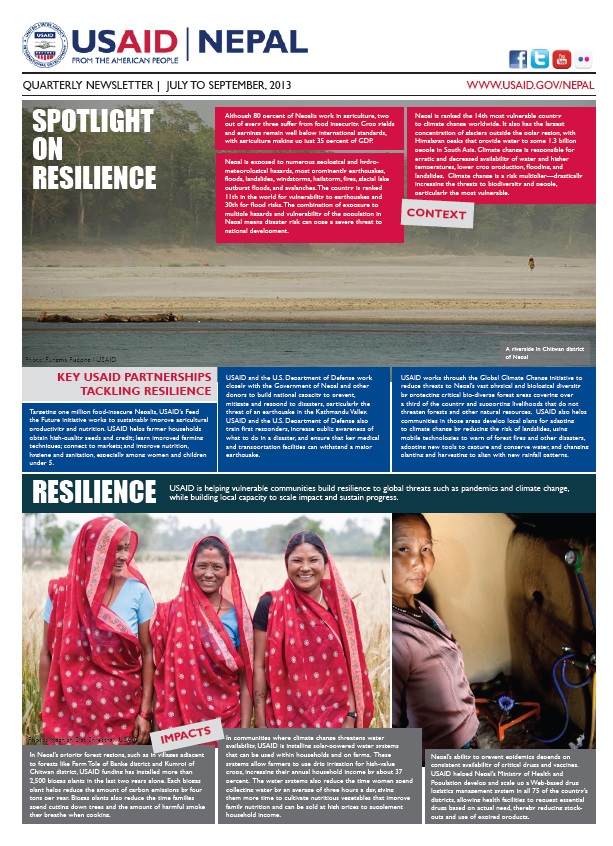Home » Spotlight on Resilience
Context:
- Although 80 percent of Nepalis work in agriculture, two out of every three suffer from food insecurity. Crop yields and earnings remain well below international standards, with agriculture making up just 35 percent of GDP.
-
Nepal is exposed to numerous geological and hydrometeorological hazards, most prominently earthquakes, floods, landslides, windstorms, hailstorm, fires, glacial lake outburst floods, and avalanches. The country is ranked 11th in the world for vulnerability to earthquakes and 30th for flood risks. The combination of exposure to multiple hazards and vulnerability of the population in Nepal means disaster risk can pose a severe threat to national development.
-
Nepal is ranked the 14th most vulnerable country to climate change worldwide. It also has the largest concentration of glaciers outside the polar region, with Himalayan peaks that provide water to some 1.3 billion people in South Asia. Climate change is responsible for erratic and decreased availability of water and highertemperatures, lower crop production, flooding, and landslides. Climate change is a risk multiplier—drastically increasing the threats to biodiversity and people, particularly the most vulnerable.
Key USAID Partnerships Tackling this Development Challenge:
-
Targeting one million food-insecure Nepalis, USAID’s Feed the Future initiative works to sustainably improve agricultural productivity and nutrition. USAID helps farmer households obtain high-quality seeds and credit; learn improved farming techniques; connect to markets; and improve nutrition, hygiene and sanitation, especially among women and children under 5.
-
USAID and the U.S. Department of Defense work closely with the Government of Nepal and other donors to build national capacity to prevent, mitigate and respond to disasters, particularly the threat of an earthquake in the Kathmandu Valley. USAID and the U.S. Department of Defense also train first responders, increase public awareness of what to do in a disaster, and ensure that key medical and transportation facilities can withstand a major earthquake.
-
USAID works through the Global Climate Change initiative to reduce threats to Nepal’s vast physical and biological diversity by protecting critical bio-diverse forest areas covering over a third of the country and supporting livelihoods that do not threaten forests and other natural resources. USAID also helps communities in those areas develop local plans for adapting to climate change by reducing the risk of landslides, using mobile technologies to warn of forest fires and other disasters, adopting new tools to capture and conserve water, and changing planting and harvesting to align with new rainfall patterns.
Impacts:
-
In Nepal’s priority forest regions, such as in villages adjacent to forests like Farm Tole of Banke district and Kumroj of Chitwan district, USAID funding has installed more than 2,500 biogas plants in the last two years alone. Each biogas plant helps reduce the amount of carbon emissions by four tons per year. Biogas plants also reduce the time families spend cutting down trees and the amount of harmful smoke they breathe when cooking.
-
In communities where climate change threatens water availability, USAID is installing solar-powered water systems that can be used within households and on farms. These systems allow farmers to use drip irrigation for high-value crops, increasing their annual household income by about 37 percent. The water systems also reduce the time women spend collecting water by an average of three hours a day, giving them more time to cultivate nutritious vegetables that improve family nutrition and can be sold at high prices to supplement household income.
-
Nepal’s ability to prevent epidemics depends on consistent availability of critical drugs and vaccines. USAID helped Nepal’s Ministry of Health and Population develop and scale up a Web-based drug logistics management system in all 75 of the country’s districts, allowing health facilities to request essential drugs based on actual need, thereby reducing stockouts and use of expired products.
Date
Friday, November 22, 2013 - 2:15am








Comment
Make a general inquiry or suggest an improvement.